Stefano L’Occaso has been the new director of the Ducal Palace in Mantua since November, having won the international competition that named him as Peter Assmann’s successor. L’Occaso, a Roman but Mantuan by adoption (he has in fact been in Mantua for more than 20 years), is one of the Palace’s deepest connoisseurs, having worked there for years as an official. After directing the Polo Museale della Lombardia for L’Occaso this is a new assignment at the head of a MiBACT institute, and the activity is already in full swing: in fact, important restoration works will start soon, there will be new layouts, renewed exhibition programming and much more. We spoke with the new director about all these issues in this interview edited by Federico Giannini.
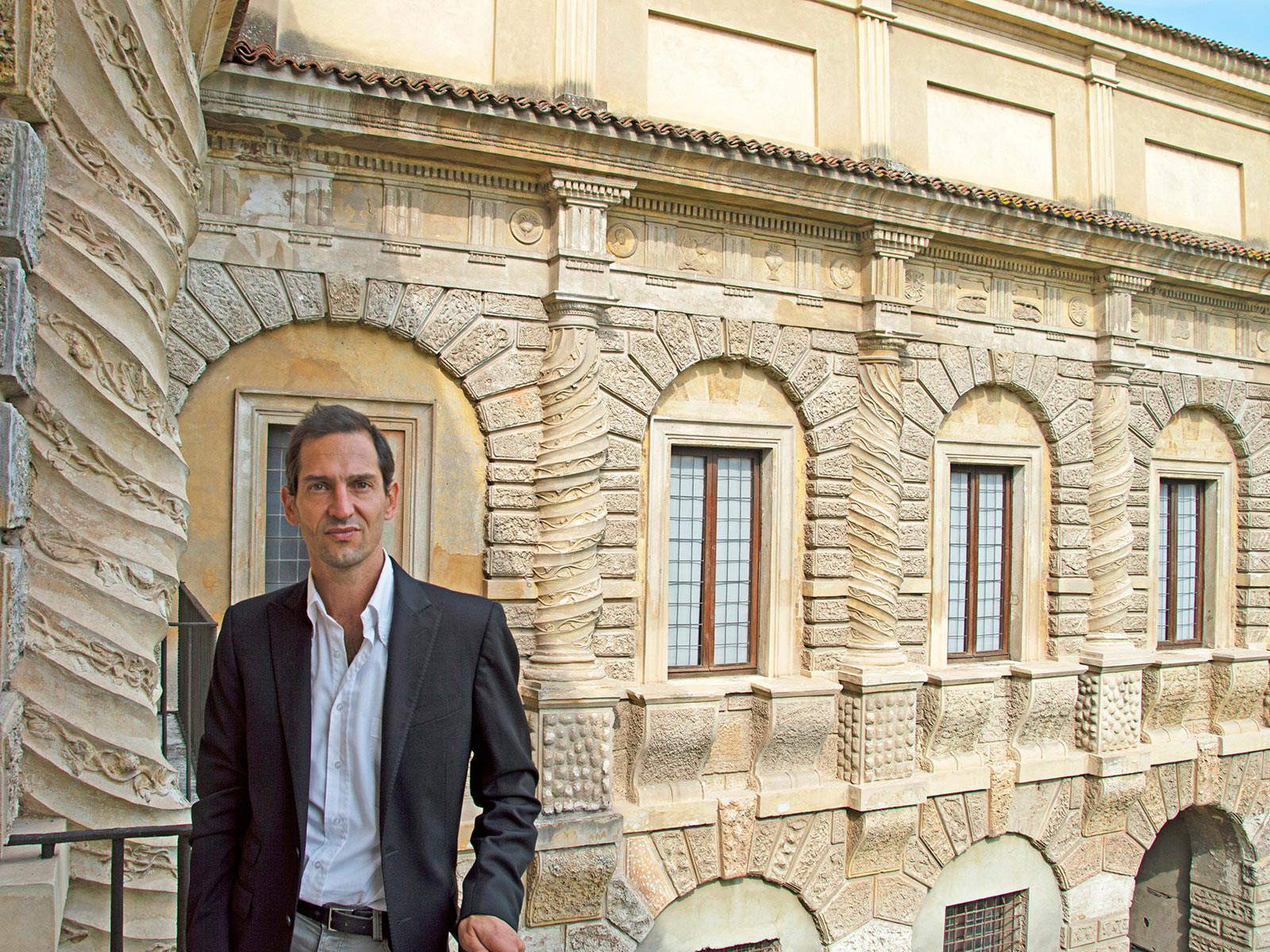 |
| Stefano L’Occaso |
FG. You arrive at the Ducal Palace after you also had a fruitful experience in thepast as director of the Polo Museale of Lombardy, appreciated also because you focused on the balance between protection and enhancement, two concepts that the ministerial reform of 2014 divided but that you with your action managed to keep together. All with excellent results in terms not only of the public but also of the realization of interventions and the involvement of private sponsors. What will you bring from that experience to the Ducal Palace?
SL. To that very useful experience I add a thorough knowledge of the Ducal Palace, since my commitment to the monument dates back to 2000, when I joined the ministry as an official art historian; so I think I am one of the greatest connoisseurs of the artistic and architectural reality of Mantua. From my work at the Lombardy Lombardy Museum Pole, I will certainly try to borrow the balance between protection and enhancement, although I have the fear that I will have to focus more on the protection aspect, at least in this incipit of my mandate, since I am inheriting substantial funding dating back to 2016 and which must be committed as quickly as possible, because the respective tenders must be awarded by December 2021, and consequently this implies a need to put maximum effort on these procedures: a complex, vast, majestic building like the Ducal Palace needs major maintenance and interventions. Moreover, its state of preservation is not excellent, and not being able to commit these resources to the protection of the building, despite the fact that it is a race against time, would be a débâcle for me.
So 2021, as he anticipated, will be a crucial year for the Doge’s Palace because several challenges await him at the gate, not least because of the tenders that will be launched for works that will affect the museum in the years to come. This is of course without calculating the tenders that have already been launched. Can you anticipate what will happen in these months?
Unfortunately, we will have the overlapping of numerous construction sites, with the risk of consequent interference. This is due to the delay in the commitment of resources: it ends up that then the construction sites will have to start, I won’t say simultaneously, but still on a very tight and close schedule. Two big construction sites are starting, one for the restoration of the porticoed side of the Cavallerizza and another for the restoration of the three towers on which no action was taken following the 2012 earthquake. Most of these interventions are entrusted to architect Antonio Mazzeri, who is the architect RUP (Single Project Manager) of these works: he is a person of great experience and great ability and at this moment he has really heavy burdens on his shoulders; so my task at this juncture is to give the maximum support to the architectural office and the technical office so that they can operate in the best conditions. This is also in order to avert two problems that have to be taken into consideration at the start of the worksites: interference with the public (and therefore the need to manage the works without them impeding, when we can reopen the museums, the passage of the public and therefore normal fruition), and interference between one worksite and another, because we will also need to intervene on very close sites if not in the same block of the Ducal Palace, with all that this entails. We have work on the facades underway: in late spring we should start a plaster restoration work on Piazza Sordello, then on the main elevations of the Palace, and we have in the tender process the restoration of the architectural volume called “Casino delle Guardie Nobili,” located in front of the exedra of the Castle. We then have the tender procedure for the restoration of the porticoed side of the Giardino dei Semplici underway, with the improvement also structural, while the three major projects are yet to be started (so we still have to get to the executive project): one is the project for the restoration and re-functionalization of the entrance to the Castle of St. George, which basically has three profiles (surface restoration, seismic improvement and structural restoration, reconfiguration of the entrance to the Castle for public reception). This worksite is presumably one of those that will start last, together with the seismic improvement and architectural restoration works of the decorated surfaces of the New Court (so we are mainly talking about the Great Apartment of Castello, according to a project that is also being drafted). The most complex work among those in the pipeline, however, is certainly the restoration of the Armory Hall, a very large volume measuring 66 by 15 meters (thus about 1.000 square meters of surface area), for an average height of 9 meters (7.40 at the impost and 9.50 at the top of the trusses): we are talking about 9,000 cubic meters that must be restored, and possibly made a museum space for future use, with all that this entails in terms of accessibility. In short, this is a very complex project for which we are working very quickly, and we are certainly not helped by Covid.
 |
| Façade of the Ducal Palace on Piazza Sordello. © MiBACT, Ducal Palace in Mantua. |
 |
| Aerial photograph of the Ducal Palace complex. © MiBACT, Ducal Palace of Mantua. |
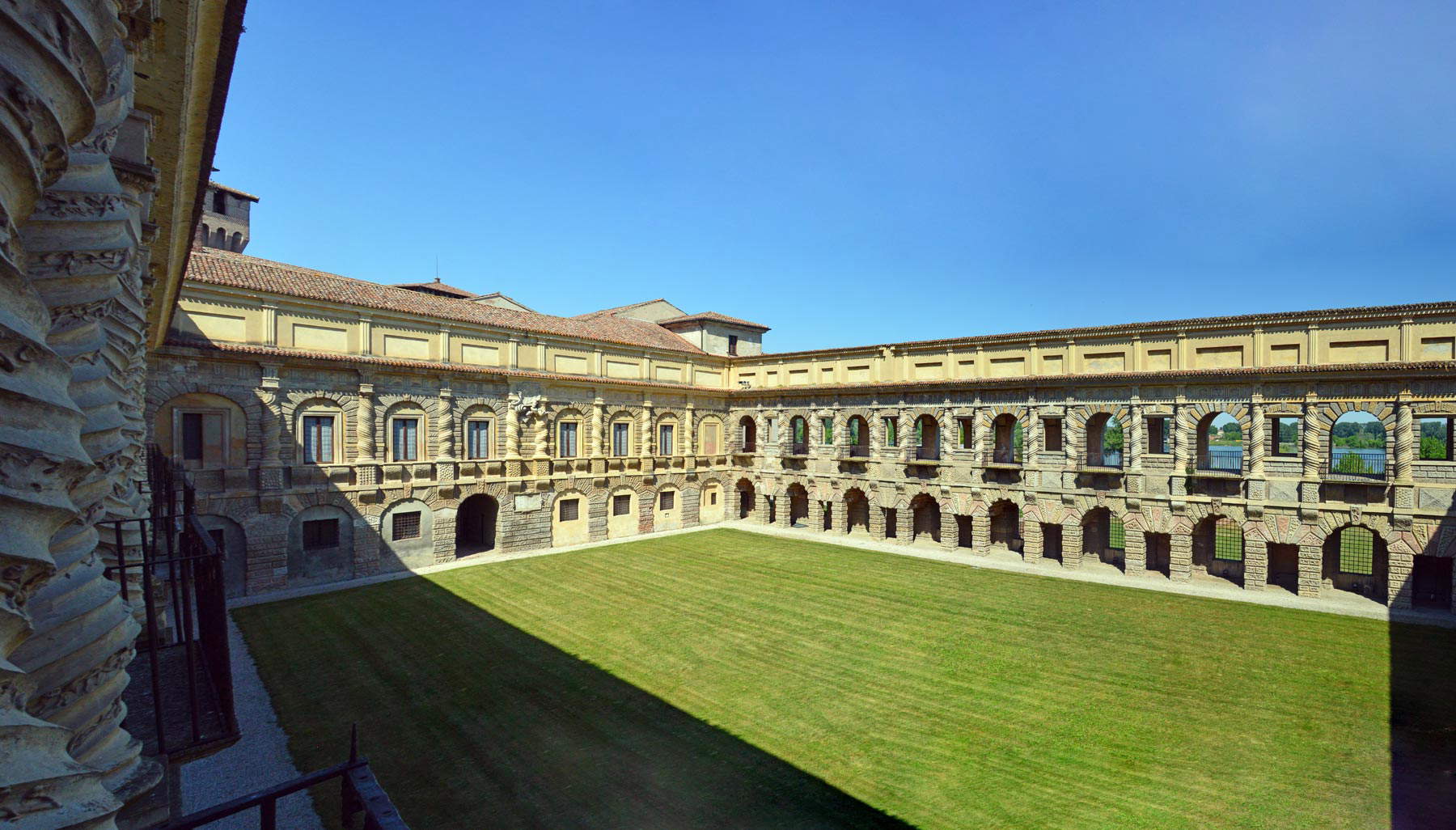 |
| The Courtyard of the Cavallerizza. © MiBACT, Ducal Palace of Mantua |
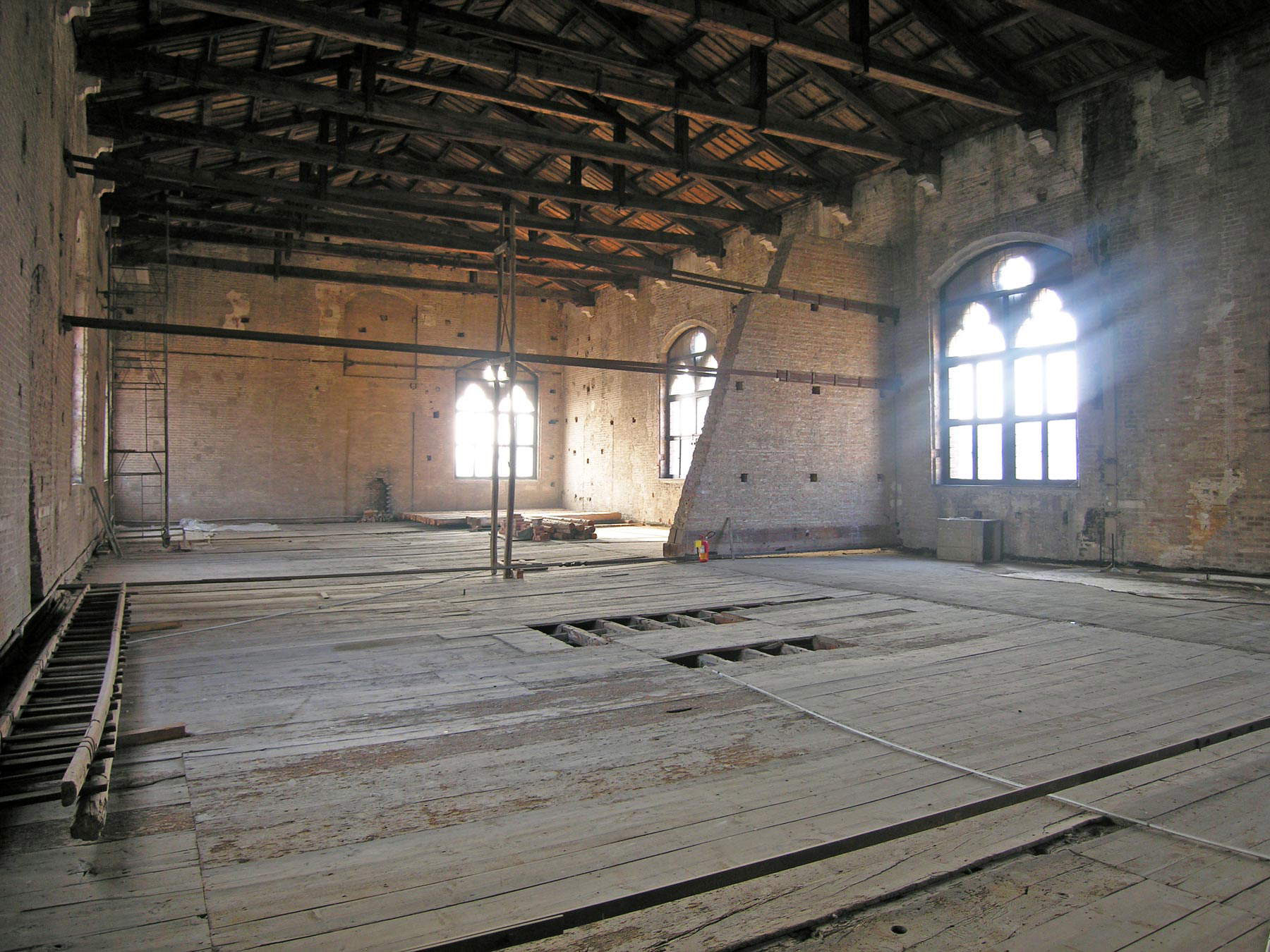 |
| The Hall of the Armory. © MiBACT, Ducal Palace of Mantua |
So the Ducal Palace, like all museums, has been closed for months, but it is in full swing, as you have just shown us. What other activities are you following in addition to the procedures for starting construction?
In mentioning our feverish activity, I would really like to thank very much all the officials of the Doge’s Palace, because they are working very hard: whether they are in attendance or whether they are remotely, they are working hard for the Doge’s Palace with more than commendable dedication. In addition to the series of works just listed (and actually the list could go on: we have a major upgrade of the security systems inside the Palace, with a 1.8-million-euro contract, a contract for fire-fighting systems, and so on), the museum is moving in various directions, in terms of retooling the permanent collections. What I intend to do, more than focusing on exhibitions, is precisely to bet on the remounting of the Palace’s permanent collections, also in collaboration with the municipality with which there has always been a very good relationship: so we are pursuing this line because here in the Ducal Palace we have collections owned by the municipality and the state, and the municipal museums also house works owned by the state. We know very well that the public is not interested in the problem of distinguishing ownership, but that everything is usable: this is the main goal and it goes hand in hand with the museum’s refurbishment. I no longer want to see the Donatello relief of the Blood of Christ or other pieces, valuable or not, in storage. The permanent exhibits will then have to be enriched by exhibitions, which are basically an “excuse” to take over the overall layout of the Ducal Palace according to an overall scheme, but one that proceeds lot by lot. So we will have the exhibition to celebrate the seven hundredth anniversary of Dante’s death, which we will open in October, and it is an opportunity to review the layout of the Appartamento di Guastalla with 14th-century sculpture and painting: the permanent layout will be enriched with loans that will come from France, Denmark and Italian museums to tell the story of the course of figurative culture in Mantua at the time of Dante. Again, the Ducal Palace is moving a great deal on acquisitions, both through donations and through purchases in the form of private treaty or other channels such as pre-emption. These procedures have led to several major acquisitions in less than three months in recent times: a drawing by Bertani, a small 14th-century sculpture, an important copy from Mantegna, a painting by Schivenoglia, a painting by Siro Baroni, and then above all the splendid tapestry, on a cartoon by Giulio Romano, which we acquired at the very end of December, managing to conclude a complex negotiation undertaken thanks to the fundamental collaboration of the General Directorate for Museums, not without an important contribution from the Fondazione Palazzo Te, which made it possible to break thedeadlock in an otherwise very complex negotiation in some way.
We have mentioned both the work on permanent collections and the work on exhibitions, and I would like to elaborate on both of these important aspects. As far as the permanent collections are concerned, we know that, among the new things, there is work on the deposits: many works now in the deposits will be exhibited to tell the public about some elements of the culture of ancient Mantua that the palace does not currently delve into. So we know that there will be a section on Jewish culture in Mantua, and one on the Wunderkammer of the Gonzaga, and I ask if you can anticipate anything about these new sections.
These are just two examples of how I would like to proceed: we have in the repositories several objects of Jewish culture, now for decades. One can well imagine the origin of the Jewish collection (the destruction of the ghetto and requisitions: so it is about violence). I would like to avoid that, in addition to the outrage of the ways in which these works are appropriated, there is a further outrage in keeping them relegated to storage facilities. I have already made contact with the Jewish community of Mantua, and there is full cooperation on their part to build an itinerary that tells the story of Jewish culture in Mantua through the centuries, and consequently the important contribution it made in the Renaissance, up to the most recent events that I believe should be told: the demolition of the ghetto or how Jewish scrolls and other materials from the synagogues or buildings of the ghetto of Mantua arrived at the Ducal Palace. It would be worse not to talk about it, to pretend that these materials do not exist and keep them in storage. We would like to find a way to present this narrative in the most objective terms possible in order to do justice to materials that so far have never been exhibited. As for the Wunderkammer, on the other hand, this is an idea that came to me one day in the repository together with colleagues: we did one of the many reconnaissance trips and I realized something I didn’t know, which is that we have whale ribs in storage, for example. These might be objects capable of intriguing the public. In fact, the idea would be to reconstruct the Gonzaga Wunderkammer, so naturalia and mirabilia that the Gonzagas had collected in the Ducal Palace, although we no longer have the objects from the Gonzaga collections that have all gone missing. However, we do have similar objects that in some way can give the emotion and restore the sense of those rooms, that is, the Gallery of Metamorphosis, so a room related and adjacent to the Gallery of the Exhibition: four rooms each dedicated to each of the four elements, capable of telling the Gonzaga taste. And if today we no longer have their collection, we can still create the suggestion of what the Ducal Palace could have been thanks to the exhibits we have in storage.
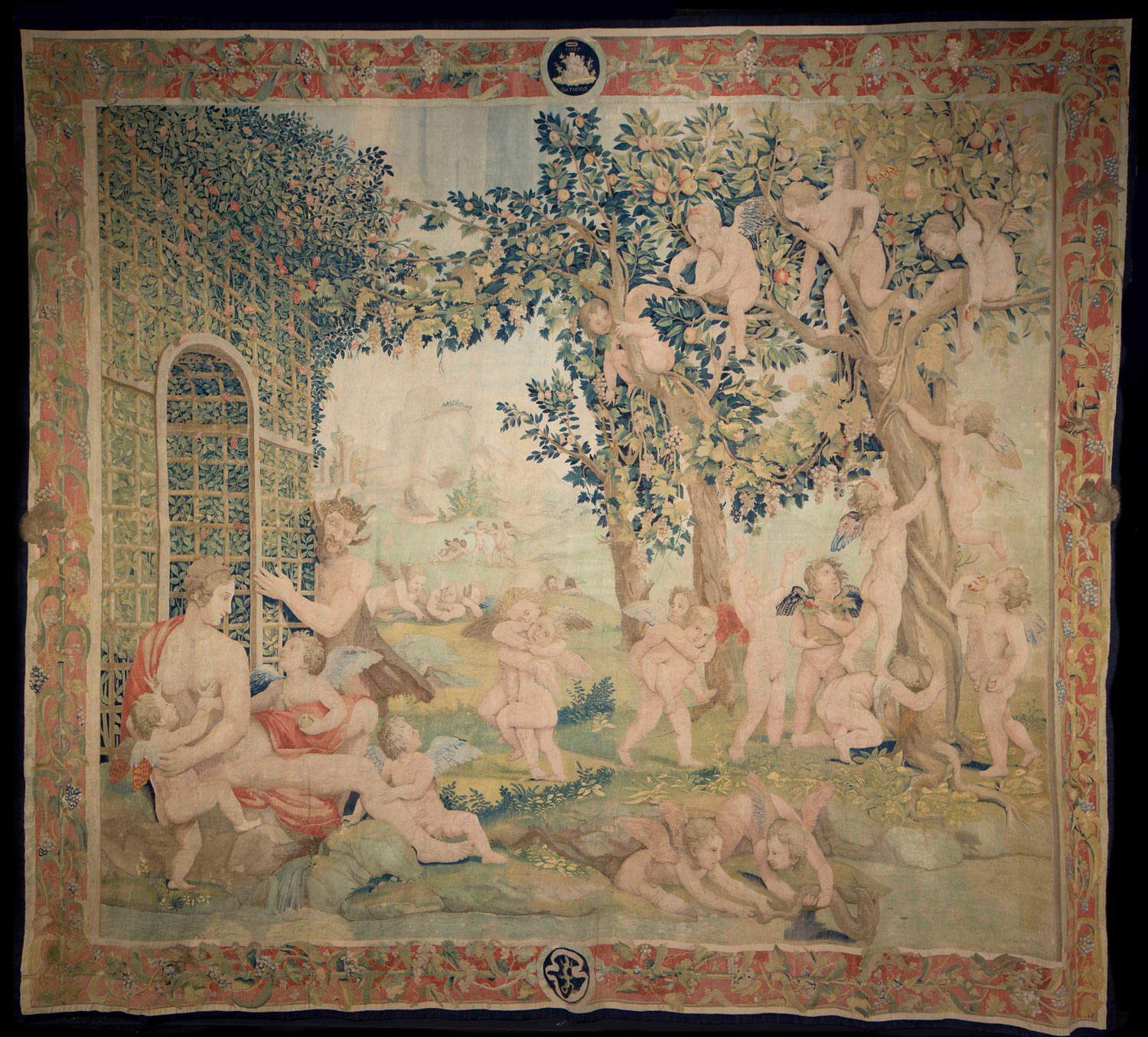 |
| Manufacture by Nicolas Karcher on cartoon by Giulio Romano, Venus spied by a satyr with cherubs (1539-1540; wool and silk tapestry; 410 x 450 cm). © MiBACT, Ducal Palace, Mantua |
 |
| Unknown artist, Figure of a saint (14th century; stone, 35 x 14 cm). © MiBACT, Ducal Palace of Mantua |
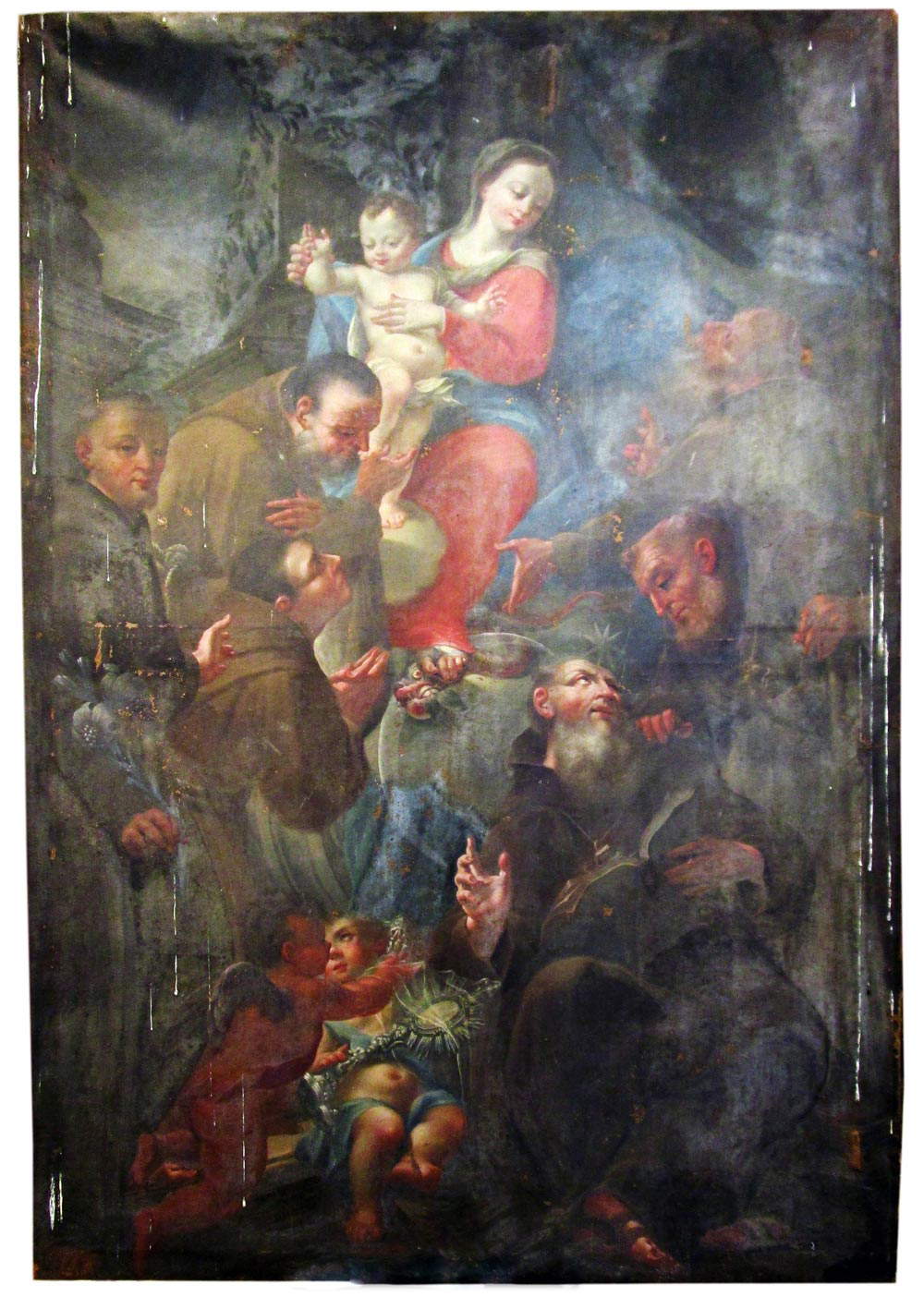 |
| Siro Baroni, Madonna and Child with Saints (1764; oil on canvas). © MiBACT, Ducal Palace of Mantua |
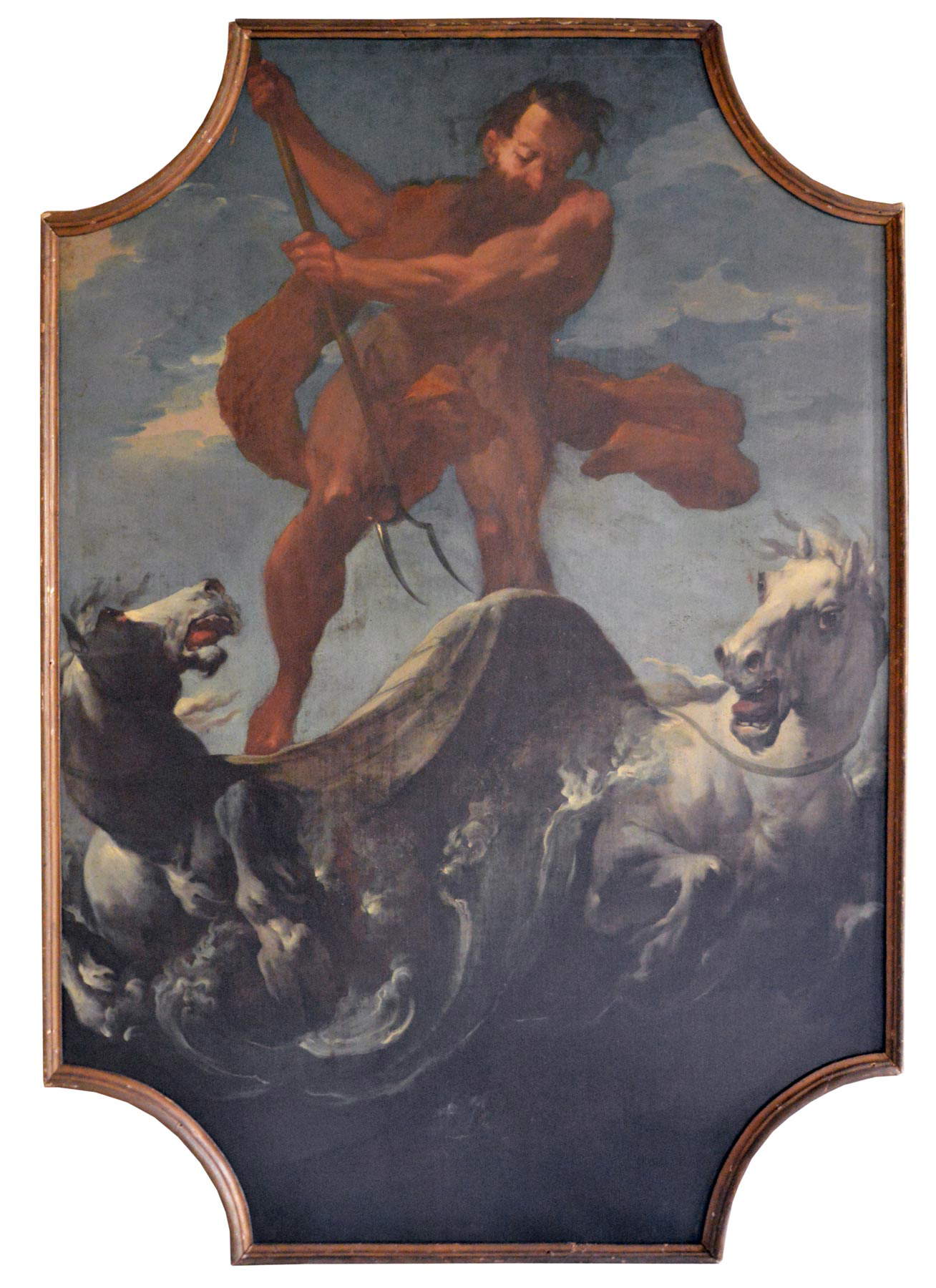 |
| Francesco Maria Raineri known as lo Schivenoglia, Neptune (c. 1745; oil on canvas, 234 x 164 cm). © MiBACT, Ducal Palace of Mantua |
 |
| Giovan Battista Bertani, Satyr Dragging Silenus’ lasinus (c. 1560-1565; pen, brown ink, watercolor ink, black stone squaring, 183 x 146 mm). © MiBACT, Ducal Palace of Mantua |
Another point of sure interest to the public is that of exhibitions: during the past administration, beyond the sharp one with the review on Giulio Romano, I would say that the quality was very uneven. In any case, your direction in this sense seems to begin in a totally opposite sign since, as you have anticipated, the first project you will be working on will be an exhibition very much linked to the territory, an exhibition moreover that promises to be of great interest because it will deal with the culture of the early fourteenth century in Mantua, in the period of transition between the Bonacolsi and Gonzaga. So I suppose that what awaits us is a programming meanwhile that is very relevant to the events of the Palace and Mantua...
Yes, you hit the nail on the head perfectly. The idea is to work on the Ducal Palace because this allows us to program permanent rearrangements, to improve the reception and narrative functions of the palace itself, so working around what the palace tells us, and then adding works that complement and comment on the monument. Our officials are active on this front, and I like to mention Maria Lucia Masciopinto and Michela Zurla, as well as Verena Frignani. I would like to make it clear that I have no preclusion towards contemporary art, which was certainly one of the workhorses of the previous management. There may also be events dedicated to contemporary art, although on this point I would prefer, because of my inadequate competence in this area, to lean on a scientific committee that may possibly be set up in the future and in which to call to collaborate people who have specific skills, so that the offer is compatible with the quality of the works of art that Palazzo Ducale has collected over the centuries. The equivalent of Rubens and Titian must be sought: we cannot have contemporary art exhibitions at all costs without checking that the quality is of an appropriate level.
Instead, taking a leap back centuries, and thus moving from the contemporary to the ancient, your direction of the Ducal Palace also sanctions a kind of return, because you, as director of the Polo Museale della Lombardia, were in charge of the complete reorganization of the National Archaeological Museum, which at the time was part of the Polo, while since 2018 it has been united with the Ducal Palace institution. How will you work on the Archaeological Museum since you contributed in a determinate way to its renovation?
I love it very much because it was a big commitment of my Milan tenure, and I have to say that right now the Archaeological Museum is in more than good condition as far as the first floor and the second floor are concerned, but not quite for the second floor. So the idea was, in cooperation with the superintendency, to make it a showcase of archaeology, of excavations in the area. The superintendency, headed by Dr. Gabriele Barucca, is doing a lot of work but does not have the opportunity to tell about its activities in the territory. The Archaeological Museum needs to be something dynamic, something alive, because it cannot not reflect the activity of protection: hence I came up with the idea of a collaboration between the two institutes. So, as early as March, hoping to be open [NB we will reopen on Wednesday, February 3], we should have a first exhibition that goes to tell about the two main excavations in the city: on our side Mari Hirose is taking care of it. Basically, we would like to make everyone participate in what archaeology is doing in our area, also because archaeology is bringing us important discoveries as far as dating early urban settlements. A first focus should be on the excavations in the area of Fiera Catena and the area of Via Rubens, a site in which traces of a baptistery were also found, perhaps Arian or at any rate with adjacent burials from the Lombard period, and precisely these excavations should find their showcase on the second floor of the Archaeological Museum. We would therefore like to tell what is happening in the area, what the superintendence is doing, and how much these excavations can increase our knowledge of the city’s earliest history.
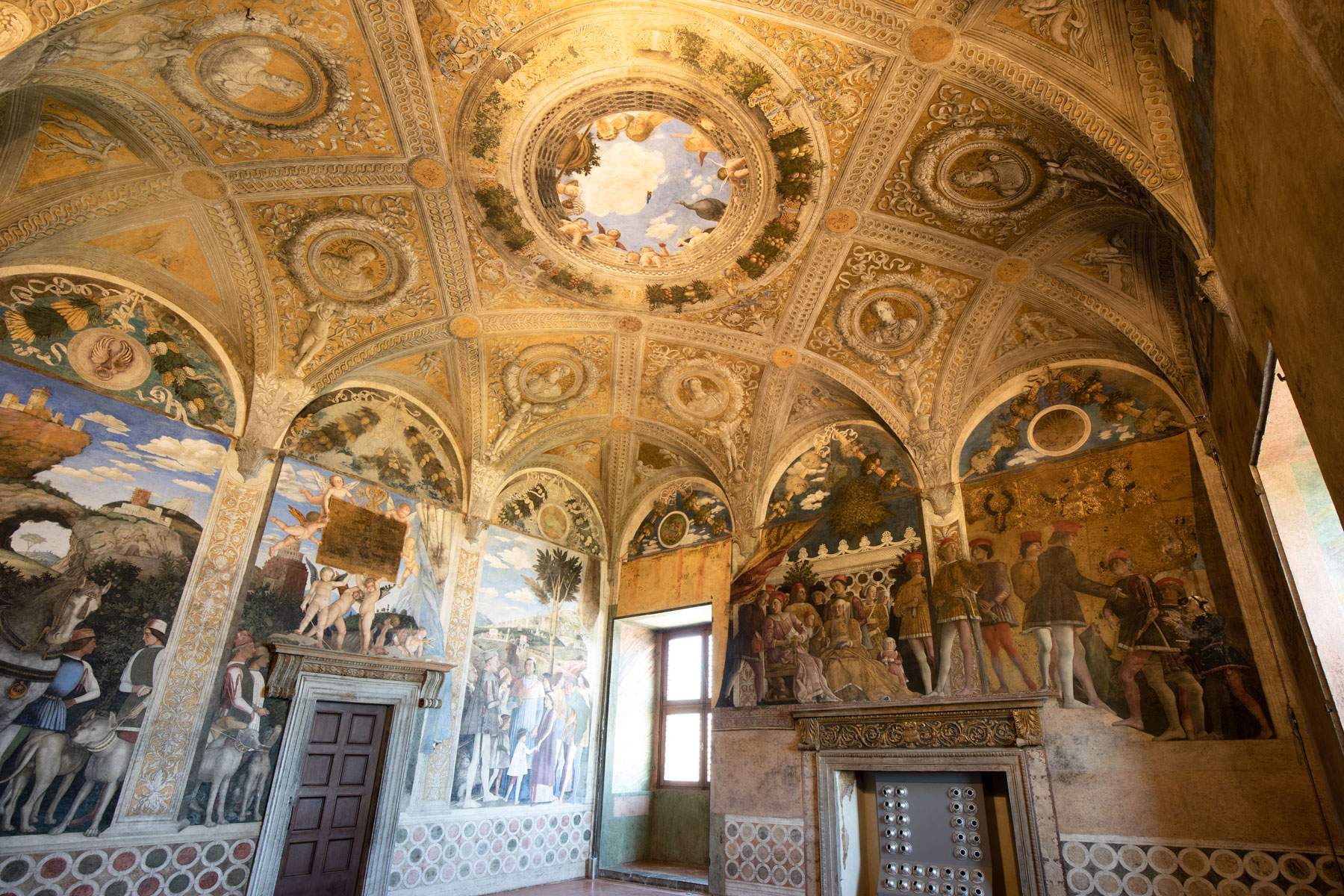 |
| The Bridal Chamber. Ph. Credit Alessandro Pasquali - Danae Project. © MiBACT, Ducal Palace of Mantua. |
 |
| The Hall of Tapestries. © MiBACT, Ducal Palace of Mantua. |
Going back to talking about the Ducal Palace, one of the institute’s long-standing problems is the small number of custodians in relation to the size of the palace, so much so that some rooms are often closed: I’m thinking, if I’m not mistaken, of the Exhibition Gallery and the Marble Gallery, which were reopened for the Giulio Romano exhibition but then closed again, or the Apartment of the Dwarfs, or the rooms of Isabella d’Este in Corte Vecchia, which are rarely opened. Will there be any developments on this chapter?
This is a very sensitive chapter because we are very hopeful about the recruitment competition for new AFAV staff (fruition, reception and supervision assistants), but in general we are very hopeful about new ministerial staff being hired on a permanent basis. We have just entered into a contract with an outside company and that will be for two years for support to our in-house staff, which is very few: we have an extremely large route with sometimes even less than 12 staff all the way through, including also the control booth and reception services: reduced to the bone. This is a serious understaffing situation compared to the vastness of the Palace. If we then think that the restorations with which we began this talk of ours should tend to lead to an expansion of the visitation route, the problem becomes even more cogent, so this support that we have today guaranteed through a contract (which is, moreover, rather onerous and therefore greatly affects the Ducal Palace’s budget) is only a palliative, because it does not solve the problem permanently. Certainly the major work on internal security systems will be able to help staff do their jobs better and thus optimize resources. Let’s also calculate that right now the staff is forced, due to extremely small numbers, to perform their duties in a diminutive way, because they can basically only do room surveillance on the huge areas of the Palace. I wish we could one day get to the point where we could say that our staff is able to provide an even broader route and also to provide a better service, because our staff often have degrees, they have the ability to give something more to the public than just keeping the halls open. And this is obviously not just a problem of the Ducal Palace-I think other directors will tell you the same things. It is certainly a widespread problem, and it is certainly a matter of general interest. I don’t know if contracts for support to the security service can be the absolute solution as a bet for the future.
To close this parenthesis, let’s talk about external services: the bookshop has been closed for a year and has not yet reopened in the summer months, plus for some time visitors have been complaining about the lack of a food court at the Ducal Palace. Will there be any changes on this point?
They are two separate issues, because the bookshop service is part of the museum services that are given under concession to a temporary business grouping, which actually has not started operating yet because of Covid. Covid, with the drastic reduction in access to the Doge’s Palace and the extended closures last year, prevented the start of the service concession. We solved this problem last year by initiating ticketing services through a bidding process: essentially, we remedied the inability to initiate museum concessions with a service contract that allowed the museum to reopen on June 5, 2020, at the end of the first prolonged lockdown. The contract, awarded prior to the passage of Law 120/2020, only allowed for the contracting out of one service, so we could not contract out a multiplicity of services and therefore had to necessarily opt for the ticketing service (it would not make sense to open the bookshop service with the museum closed). Today, the amendment to the Contract Code in Law 120 would also allow for plurality of services: the problem is that the threshold for contracting out the service does not put us in a position to expand the offer. As a result, the bookshop will reopen when the service concession starts. On the start of the service concession, another quite complex chapter opens, because obviously at a stage when the revenue forecast from the concessionaire is drastically reduced, it is clear that the start of services becomes a negotiation that is not easy to manage. The number of visitors dropped dramatically last year, but even if we were to reopen tomorrow (assuming Lombardy becomes a yellow zone we would be ready to reopen in two or three days, because it’s just a matter of clearing the path from the scaffolding we need for the maintenance we are carrying out at this time), we would have to reopen with contingency, spacing, and whatever else is necessary to ensure a safe visit for staff and public: this means that the museum’s capacity would be less than the theoretical capacity of a museum like the Ducal Palace. So the numbers achieved in 2019, thanks in part to the Giulio Romano exhibition, record numbers, will be impossible to repeat during 2021: and the premises are not the best. That said, it is clear that museum services will also have to be scaled back somewhat to allow for sustainability on the part of the concessionaire. As far as catering is concerned, the concession for cafeteria services stalled two or three years ago in the face of a lack of economic operators (basically no one participated in the procedure announced by the Ducal Palace), and this was because a commitment was also required in economic terms in the start-up of the works and for a whole series of plant adaptations within the designated spaces. I believe that under these conditions it will be difficult to find an entity that today, even more than two years ago, is willing to invest certain amounts to open a cafeteria. I believe that if we want to start this service we will have to find a different, quicker and more effective way, perhaps giving up the cafeteria-restaurant combination, perhaps focusing only on the cafeteria, at least for a period of time, because otherwise I believe that today the proposal launched by the administration two years ago (precisely of the combination of the two services with the related charges) is not sustainable for an economic operator. Under those conditions we would face another negative outcome of a procedure, which moreover I must admit is not a priority at this time. Now I have an absolute need to start the tenders for the restoration work, because the Palace is in enormous need of maintenance and restoration (we have areas that would still be unusable as a result of the 2012 earthquake), and I must necessarily commit to this front as an absolute urgency. When we get the bidding process for the work underway, then we will take up this issue as well.
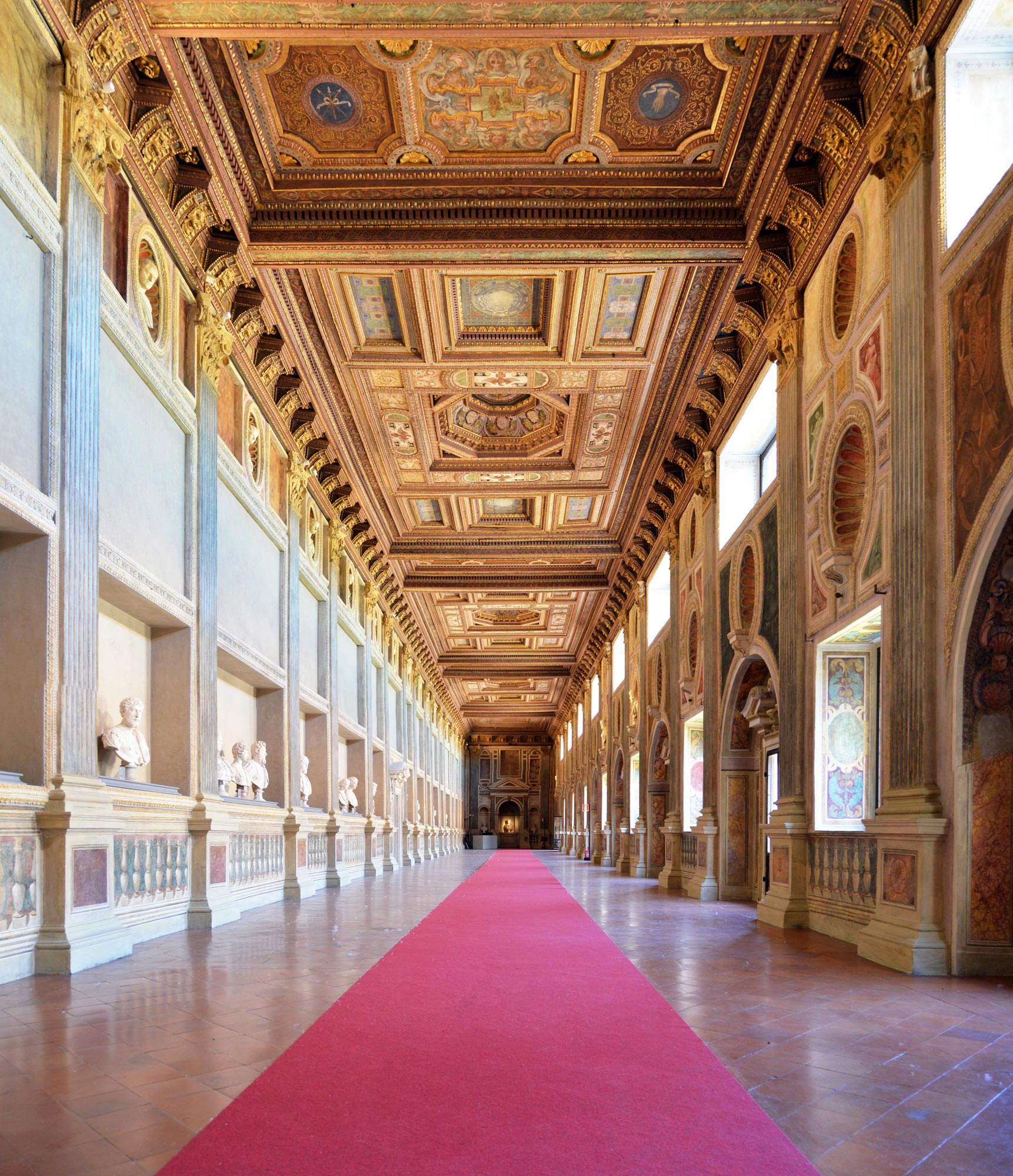 |
| The Exhibition Gallery. © MiBACT, Ducal Palace of Mantua. |
 |
| The storerooms of the Ducal Palace. © MiBACT, Ducal Palace of Mantua. |
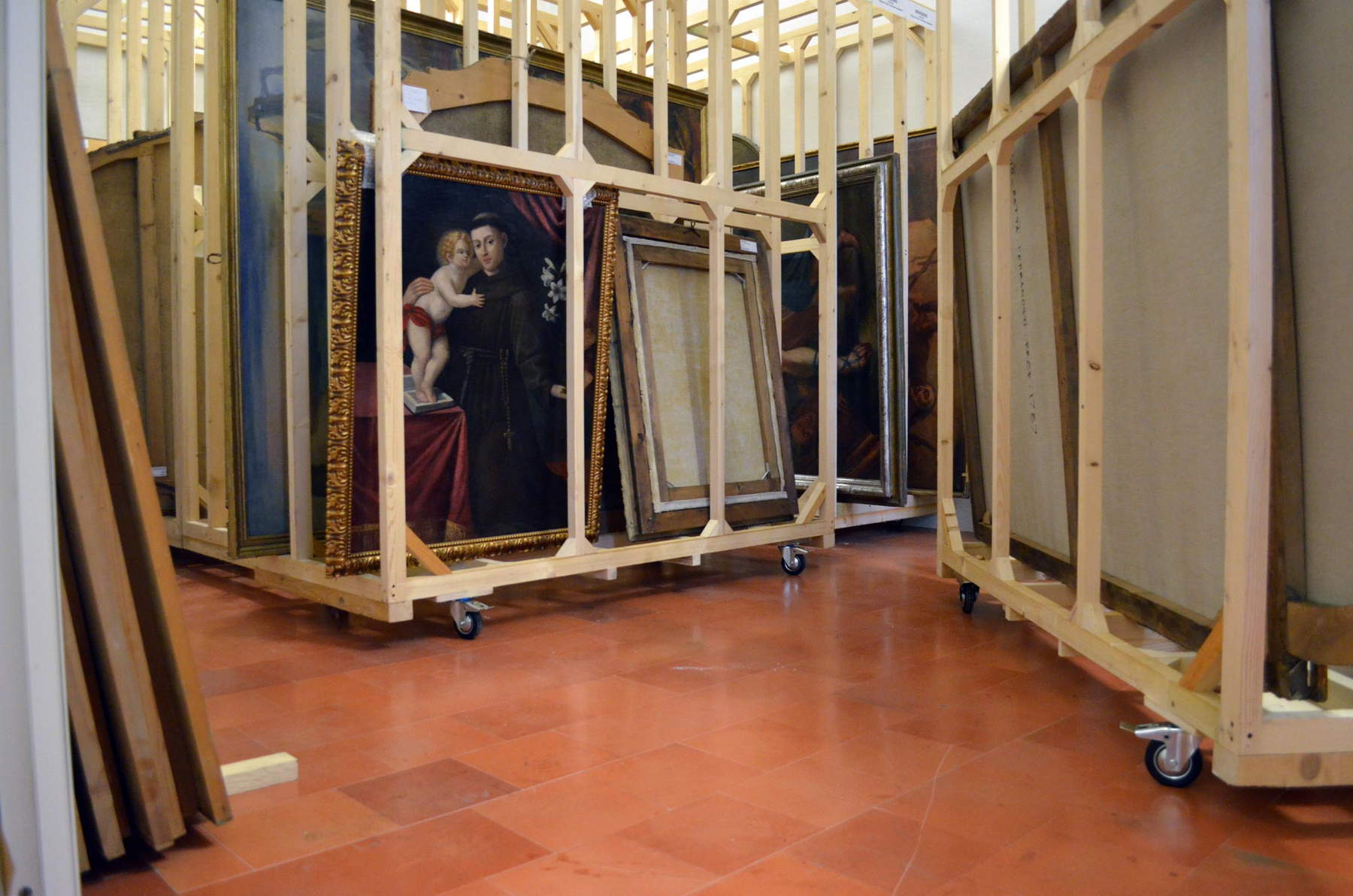 |
| The storerooms of the Ducal Palace. © MiBACT, Ducal Palace of Mantua |
Let’s talk about digital instead: the Ducal Palace is a very active institution in this sense, it has a website that is a rich source of information and I would say it is among the most up-to-date and interesting sites in the entire national museum scene, an effective social presence, and in general it enjoys a I would say very intelligent use of digital resources. There is a lot of talk about digital these months: what is your approach?
I’m very pleased with what it says about our site, but I have to say that it is mostly thanks to Alessandro Sartori, the communications officer who very intelligently manages our site with the collaboration of Ylenia Apollonio. We have also recently uploaded an introductory video in English that will want to be a kind of business card for when the borders reopen and the public can come from abroad as well. We are also working on digital, although the Palace from this point of view does not lend itself very much, because we have no internal fiber connection, no line connection that would allow us to start big projects for what concerns for example augmented reality or apps, but also simply QR Codes. We basically don’t have the infrastructure that would allow us to run a proper digital service, but we are providing for that as well, because the huge project that is in the hands of engineer Fabrizio D’Amato on improving the technological infrastructure of the Palace should allow, in the not immediate but not too distant future, a big improvement and therefore a possible revitalization and investment also in terms of digitization. We are also working on the digitization of the collections and then also on cataloging projects: among the staff employed in the office, those who are not purely related to the architectural office and the technical office can work on this front.
I would like to conclude the interview by mentioning the Ducal Palace subscription, which is a very interesting initiative that is very popular with the public and shows how it is possible to incentivize people to make repeated returns to the museum. But in this sense you have already announced a free admission when the doors of the Ducal Palace reopen, and after all, the need to work a lot on the local community is being stressed from many quarters at this time. What are your ideas in this regard? How will the museum work toward the community and why is it so important?
Gratuity is exactly that: it is a message sent to the city precisely to say “we are there, we are with you, we have to work together.” We know very well that Palazzo Ducale is the engine of the tourist economy in the city (the other hub is Palazzo Te), but there are also other wonderful city realities (Diocesan Museum, Palazzo D’Arco, Teatro Bibiena and so on): it is obvious that we are not alone, however, Palazzo Ducale has a strategic role. Gratuity means “let’s restart and make an effort so that you can start working again as well.” With the local reality, relations are very good: we are working on several fronts, we have a subscription and ticketing network both on a regional scale (the Musei Lombardia subscription) and on a city scale, and we also have more punctual offers, for example the proposal The Sky in a Room with Palazzo D’Arco (for the Falconetto Room), Palazzo Te (for the Sala dei Giganti) and us with the Bridal Chamber. This is an agreement to create a focus on a specific theme, but of course we are also working with the other entities on longer-term projects. There have already been fruitful meetings with the mayor on the issue of the collection that I mentioned earlier, and I think there are all the conditions to work in the best way so that eventually the collections, regardless of ownership, can all be for public enjoyment. One project that I would very much like to see get off the ground concerns the collections of the nineteenth and twentieth centuries, because, as a prelude to the jubilation of the Mantuan Renaissance, we have managed to create a good Archaeological Museum that tells the story of the city from its origins, but the more recent time segment is missing: somehow the narrative of Mantuan history and art stops at the early 19th century, at Neoclassicism, and instead I think we also need to continue the narrative with the history of the arts in Mantua between the 19th and 20th centuries. It is a project we are working on, together with others, and I think the best way to work on it is in a network with other cultural realities in the city. Palazzo Ducale is not an isolated reality, and it will work best in dialogue with other institutions.
Warning: the translation into English of the original Italian article was created using automatic tools. We undertake to review all articles, but we do not guarantee the total absence of inaccuracies in the translation due to the program. You can find the original by clicking on the ITA button. If you find any mistake,please contact us.